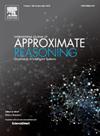Dynamic concept reduction methods based on local information
IF 3
3区 计算机科学
Q2 COMPUTER SCIENCE, ARTIFICIAL INTELLIGENCE
引用次数: 0
Abstract
Knowledge reduction is one of the core research issues in formal concept analysis. As a new technique of knowledge reduction, concept reduction has received increasing attention recently. One typical method of calculating concept reducts is based on representative concept matrix (RC-matrix, for short), which can obtain all concept reducts. However, it is confronted with the following challenges: (1) before the construction of the RC-matrix, all concepts of the formal context need to be calculated, which is both time and space consuming; (2) there is a lot of redundant information in the constructed RC-matrix, which is not helpful to calculate the concept reducts; (3) when the data changes dynamically, the concept reducts need to be calculated for scratch. To address these issues, dynamic concept reduction methods based on local information are proposed in this paper. Firstly, the characteristics of the minimal elements (with respect to set inclusion) in the RC-matrix are analyzed, and all the minimal elements are directly labeled from the formal context; secondly, the advantage of local information is taken to construct each minimal elements of the RC-matrix, from which all the concept reducts can be obtained; besides, a new simplified version of RC-matrix, named as Type-I minimal RC-matrix, is further constructed to compute one concept reduct; and finally, when data dynamically changes, the connections between concept reducts of the original formal context and those of the new one are analyzed, consequently, two dynamic concept reduction algorithms are proposed.
基于局部信息的动态概念约简方法
知识约简是形式概念分析的核心研究问题之一。概念约简作为一种新的知识约简技术,近年来受到越来越多的关注。计算概念约简的一种典型方法是基于代表性概念矩阵(简称RC-matrix),它可以得到所有的概念约简。然而,它面临着以下挑战:(1)在构建rc矩阵之前,需要计算形式语境的所有概念,这既费时又耗空间;(2)构造的rc -矩阵中存在大量冗余信息,不利于概念约简的计算;(3)当数据发生动态变化时,需要对概念约简进行划痕计算。针对这些问题,本文提出了基于局部信息的动态概念约简方法。首先,分析了rc矩阵中最小元素(相对于集合包含)的特征,并从形式上下文直接标记了所有的最小元素;其次,利用局部信息的优势构造rc矩阵的每个最小元素,从中得到所有的概念约简;进一步构造了一个新的简化版rc -矩阵,命名为Type-I最小rc -矩阵,计算一个概念约简;最后,在数据动态变化的情况下,分析了原形式上下文的概念约简与新形式上下文的概念约简之间的联系,从而提出了两种动态概念约简算法。
本文章由计算机程序翻译,如有差异,请以英文原文为准。
求助全文
约1分钟内获得全文
求助全文
来源期刊

International Journal of Approximate Reasoning
工程技术-计算机:人工智能
CiteScore
6.90
自引率
12.80%
发文量
170
审稿时长
67 days
期刊介绍:
The International Journal of Approximate Reasoning is intended to serve as a forum for the treatment of imprecision and uncertainty in Artificial and Computational Intelligence, covering both the foundations of uncertainty theories, and the design of intelligent systems for scientific and engineering applications. It publishes high-quality research papers describing theoretical developments or innovative applications, as well as review articles on topics of general interest.
Relevant topics include, but are not limited to, probabilistic reasoning and Bayesian networks, imprecise probabilities, random sets, belief functions (Dempster-Shafer theory), possibility theory, fuzzy sets, rough sets, decision theory, non-additive measures and integrals, qualitative reasoning about uncertainty, comparative probability orderings, game-theoretic probability, default reasoning, nonstandard logics, argumentation systems, inconsistency tolerant reasoning, elicitation techniques, philosophical foundations and psychological models of uncertain reasoning.
Domains of application for uncertain reasoning systems include risk analysis and assessment, information retrieval and database design, information fusion, machine learning, data and web mining, computer vision, image and signal processing, intelligent data analysis, statistics, multi-agent systems, etc.
 求助内容:
求助内容: 应助结果提醒方式:
应助结果提醒方式:


